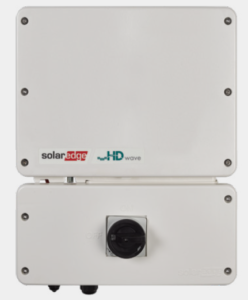
The executive summary is that one of the inverters in our solar panel system seems to have failed, so we are only generating about half as much energy as normal. The inverter will soon be replaced, and then we ought to be back to a normal level of energy generation. The inverter failed on about April 16, but I did not catch on that it had failed until just a week ago. If only I had set up an email alert back when the system was first installed, I could have learned about the inverter failure on the same day that it happened. I have just now turned on the email alert.
Here are the details.
![]() Our solar panel system got installed around 2½ years ago. The company that made the inverters (SolarEdge) provides a cloud-based monitoring system at no extra charge. The monitoring system makes possible a display screen in our kitchen which queries the cloud to get information so that it can show us the present level of energy production as well as the production in the past few days.
Our solar panel system got installed around 2½ years ago. The company that made the inverters (SolarEdge) provides a cloud-based monitoring system at no extra charge. The monitoring system makes possible a display screen in our kitchen which queries the cloud to get information so that it can show us the present level of energy production as well as the production in the past few days.
The cloud-based monitoring system also provides a homeowner portal that lets us drill down to see the production of each of the 54 solar panels. So for example if one panel were to fail, we could see which one has failed.
It turns out that if I had only thought to do it, I could have set up our account in the cloud-based monitoring system so that it would send us alerts when something goes wrong.
What got me to pay attention to this is that a week ago or so, sort of by chance, I did some drilling-down in the portal to see the energy production of various parts of our system, and eventually I got a clue and I realized the monitoring system was telling me that one of our inverters is not generating any electricity.
Yes, “one of our inverters”. As you can see here, the 54 panels on our roof are divided into two groups of 27 panels each. A first group of 27 panels is connected to a first inverter, and a second group of 27 panels is connected to a second inverter. One of the inverters failed on April 16, 2024. The other inverter is working fine. Here is the daily alert that arrived yesterday evening:
| Summary of the alerts | ||||||
| Report generated on: | 05/03/2024 22:24 | |||||
| Site Name | Country | State |
City | Alert Type | Category | Opened |
| PROJ-nnnnn tttttttttttttttt | United States | Colorado | Cccccccc | Inverter not producing energy – low Voltage |
EQUIPMENT | 05/03/2024 19:06 |
As you can see the report is telling me that we have an inverter that is not producing energy. I only thought to turn on these alerts a couple of days ago. If I had set up these alerts back when the system was installed, I would have learned of this problem on the day that it happened (April 16).
 The company that designed and installed our solar panel system (Photon Brothers) designed it from the outset to use two inverters of 7.6 kW each, rather than using a single bigger inverter. One consequence of this is what I am describing here. The risk of inverter failure is spread out — even if one inverter were to fail, the other inverter might still be working. And that is what we have now.
The company that designed and installed our solar panel system (Photon Brothers) designed it from the outset to use two inverters of 7.6 kW each, rather than using a single bigger inverter. One consequence of this is what I am describing here. The risk of inverter failure is spread out — even if one inverter were to fail, the other inverter might still be working. And that is what we have now.
On the day that I was clicking around in the portal and stumbled on the fact that we had a broken inverter, I right-clicked on the icon for the inverter that was on the screen, and a chatbot from SolarEdge popped up. The chatbot cheerfully explained that it is here to help. It then further explained that it had noticed that one of the inverters appears to have failed. It then asked if I would like to hear whether the inverter is still in warranty. I said “sure”. The chatbot reported that it had looked up the serial number of this inverter in the warranty database, and it found that the inverter is indeed still in warranty. The chatbot asked if I would like to open a trouble ticket to arrange for a warranty replacement inverter to be sent out. I said “sure”. The chatbot gave me the trouble ticket number.
Now I know what you are thinking. You are wondering, what if the problem is not the supposedly failed inverter at all, but instead what if the real source of the problem is somewhere upstream? What if, for example, the problem is a broken connection between the maybe-failed inverter and its respective 27 solar panels?
I wondered this myself. Eventually I did some hands-on testing of the various system elements. One of the tests I did was to swap the two groups of 27 panels. I took the 27 panels that were normally connected to the maybe-failed inverter, and I connected them to the known-good inverter. And sure enough, the known-good inverter was able to register its connection with all 27 of those panels, and was able to generate electricity normally. This test (together with some other tests that I did) permitted me to be quite confident that the culprit really was the bad inverter itself, and not any of the upstream parts of the system.
Further clicking around on the web site of SolarEdge permitted me to get a detailed warranty-status report, and it turns out the warranty on this inverter does not expire until the year 2046.
Another thing that I did when I learned of this inverter failure was, I went to the web site of Photon Brothers and I opened a trouble ticket there as well. A couple of days later I heard back from my new best friend (I’ll call him Bill) at Photon Brothers. Bill was calling to say that he had looked into my trouble ticket and he had carried out some remote diagnostics. He had already decided from his test results that the problem was a failed inverter and not the upstream parts of the system.
It was left that Bill will let me know when his company receives the warranty replacement inverter from SolarEdge, and then he will arrange for a truck roll for one of his colleagues to drive up here (they are 75 miles away) and replace the inverter. This work will all be done free of charge because Photon Brothers also provides warranty service on all of these things.
SolarEdge did a redesign of the heat sink on this model of inverter a couple of years ago, and the new version of this inverter sticks out from the wall about half an inch more than before. This is because the fins of the heat sink are longer. This could be a problem for a homeowner if the connections to the inverter happened to be, for example, rigid electrical conduits. In our case, all of the connections are flexible conduits. So the flexible conduits will be able to flex slightly to accommodate the new spacing that is half an inch further out from the wall.
One Reply to “A report that I ought to have configured three years ago”